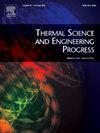Exploring radiative heat transfer and buoyancy effects on Tiwari-Das nanofluid flow model in permeable rotating disc: Finite element study
IF 5.4
3区 工程技术
Q2 ENERGY & FUELS
引用次数: 0
Abstract
Nanofluids are identified for their improved thermal conductivity and are progressively used in heat transfer advancements such as cooling mechanisms and energy systems. This investigation offers an inclusive analysis of the interaction between nanoparticle volume fraction, rotational motion, and thermal radiation on thermal distribution characteristics. Hence, this research focuses on the effect of radiating heat transport on the thermal and flow behavior of a nanofluid along a porous rotating disc in the presence of buoyancy forces using the Tiwari-Das model. A system of coupled partial differential models for the momentum, thermal, and nanoparticle species is developed with boundary film approximations. The Tiwari-Das equation is utilized to capture the impact of dispersed nanoparticles on the working solvent’s thermophysical properties. Using separately the Rosseland and Boussinesq approximations, the heat radiation and density variations of buoyancy effects are modeled. The resultant nonlinear derivative equations are solved via a finite element method to ensure solution accuracy and stability. The effect of various entrenched parameters on the flow mechanics and heat transport rates is examined. The outcomes of the study depicted that raising the nanoparticle volume fraction boosts the effectiveness of heat transfer, while thermal radiation flux pointedly varies in temperature distributions. Buoyancy forces prompt the flow structure, causing a variation in thermal and velocity boundary layers. Thus, this study promotes the thermal performance of nanofluid, presenting possible control mechanisms for heat transfer optimization.
Tiwari-Das纳米流体在可渗透旋转圆盘内流动模型的辐射传热和浮力效应:有限元研究
纳米流体因其改善的导热性而被确定,并逐渐用于传热的进步,如冷却机制和能源系统。这项研究提供了纳米颗粒体积分数、旋转运动和热辐射对热分布特征的相互作用的全面分析。因此,本研究的重点是利用Tiwari-Das模型研究在浮力作用下,纳米流体沿多孔旋转盘的热和流动行为在辐射热传输中的影响。一个系统的耦合偏微分模型的动量,热,和纳米粒子的物种发展与边界膜近似。Tiwari-Das方程用于捕捉分散的纳米颗粒对工作溶剂热物理性质的影响。分别使用Rosseland近似和Boussinesq近似,模拟了浮力效应的热辐射和密度变化。为保证求解的精度和稳定性,采用有限元法对所得到的非线性微分方程进行求解。考察了各种固定参数对流动力学和传热率的影响。研究结果表明,纳米颗粒体积分数的提高提高了换热效果,而热辐射通量在温度分布上有明显的变化。浮力促使流动结构,引起热边界层和速度边界层的变化。因此,本研究促进了纳米流体的热性能,提出了优化传热的可能控制机制。
本文章由计算机程序翻译,如有差异,请以英文原文为准。
求助全文
约1分钟内获得全文
求助全文
来源期刊

Thermal Science and Engineering Progress
Chemical Engineering-Fluid Flow and Transfer Processes
CiteScore
7.20
自引率
10.40%
发文量
327
审稿时长
41 days
期刊介绍:
Thermal Science and Engineering Progress (TSEP) publishes original, high-quality research articles that span activities ranging from fundamental scientific research and discussion of the more controversial thermodynamic theories, to developments in thermal engineering that are in many instances examples of the way scientists and engineers are addressing the challenges facing a growing population – smart cities and global warming – maximising thermodynamic efficiencies and minimising all heat losses. It is intended that these will be of current relevance and interest to industry, academia and other practitioners. It is evident that many specialised journals in thermal and, to some extent, in fluid disciplines tend to focus on topics that can be classified as fundamental in nature, or are ‘applied’ and near-market. Thermal Science and Engineering Progress will bridge the gap between these two areas, allowing authors to make an easy choice, should they or a journal editor feel that their papers are ‘out of scope’ when considering other journals. The range of topics covered by Thermal Science and Engineering Progress addresses the rapid rate of development being made in thermal transfer processes as they affect traditional fields, and important growth in the topical research areas of aerospace, thermal biological and medical systems, electronics and nano-technologies, renewable energy systems, food production (including agriculture), and the need to minimise man-made thermal impacts on climate change. Review articles on appropriate topics for TSEP are encouraged, although until TSEP is fully established, these will be limited in number. Before submitting such articles, please contact one of the Editors, or a member of the Editorial Advisory Board with an outline of your proposal and your expertise in the area of your review.
 求助内容:
求助内容: 应助结果提醒方式:
应助结果提醒方式:


